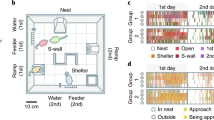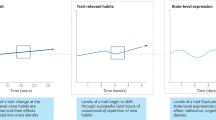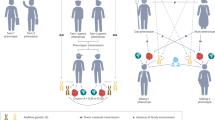Abstract
Human and animal behaviour exhibits complex but regular patterns over time, often referred to as expressions of personality. Yet it remains unclear what personality really is: is it just the behavioural patterns themselves, something in the brain, in the genes or perhaps all of these? Here we offer a set of causal hypotheses about the role of personality, integrating psychological and neuroscientific approaches to personality in a testable framework. These hypotheses clarify the causal and constitutive relations that personality has with genes, environment, brain, mind and behaviour, and we suggest specific experiments that can adjudicate amongst the different hypotheses. We focus on a set of models that propose that personality is instantiated in the brain, distally caused by genes and environment and, in turn, causing the overt behaviours from which it is often inferred. We argue that articulating and testing such models will be essential in a mature science of personality.
This is a preview of subscription content, access via your institution
Access options
Access Nature and 54 other Nature Portfolio journals
Get Nature+, our best-value online-access subscription
$29.99 / 30 days
cancel any time
Subscribe to this journal
Receive 12 digital issues and online access to articles
$119.00 per year
only $9.92 per issue
Buy this article
- Purchase on Springer Link
- Instant access to full article PDF
Prices may be subject to local taxes which are calculated during checkout



Similar content being viewed by others
References
Feist, J. & Feist, G.J. Theories of Personality (McGraw-Hill Education, 2008).
Eysenck, H.J. Biological dimensions of personality. in Handbook of Personality: Theory and Research (ed. Pervin, L. A.) 244–276 (Guilford Press, 1990).
Borgatta, E. F. The structure of personality characteristics. Behav. Sci. 61, 8–17 (1964).
Fiske, D. W. Consistency of the factorial structures of personality ratings from different sour sources. J. Abnorm. Psychol. 44, 329–344 (1949).
Norman, W. T. Toward an adequate taxonomy of personality attributes: replicated factors structure in peer nomination personality ratings. J. Abnorm. Soc. Psychol. 66, 574–583 (1963).
Smith, G. M. Usefulness of peer ratings of personality in educational research. Educ. Psychol. Meas. 27, 967–984 (1967).
Tupes, E.C. & Christal, R.E. Recurrent personality factors based on trait ratings. Technical Report ASD-TR-61-97 http://www.dtic.mil/dtic/tr/fulltext/u2/267778.pdf (USAF, 1961).
Goldberg, L. R. Language and individual differences: The search for universals in personality lexicons. Rev. Pers. Soc. Psychol. 2, 141–165 (1981).
McCrae, R. R. & John, O. P. An introduction to the five-factor model and its applications. J. Pers. 60, 175–215 (1992).
DeYoung, C. G., Quilty, L. C. & Peterson, J. B. Between facets and domains: 10 aspects of the Big Five. J. Pers. Soc. Psychol. 93, 880–896 (2007).
Cattell, R. B. The description of personality: principles and findings in a factor analysis. Am. J. Psychol. 58, 69–90 (1945).
Costa, P. T. & McCrae, R. R. Six approaches to the explication of facet-level traits: examples from conscientiousness. Eur. J. Pers. 12, 117–134 (1998).
Mõttus, R., Kandler, C., Bleidorn, W., Riemann, R. & McCrae, R. R. Personality traits below facets: The consensual validity, longitudinal stability, heritability, and utility of personality nuances. J. Pers. Soc. Psychol. 112, 474–490 (2017).
Forkosh, O. et al. Identity domains capture individual differences from across the behavioral repertoire. Nat. Neurosci. 22, 2023–2028 (2019).
Baumert, A. et al. Integrating personality structure, personality process, and personality development. Eur. J. Pers. 31, 503–528 (2017).
Eysenck, H. J. Personality and experimental psychology: the unification of psychology and the possibility of a paradigm. J. Pers. Soc. Psychol. 73, 1224–1237 (1997).
Shalizi, C. R. & Crutchfield, J. P. Information bottlenecks, causal states, and statistical relevance bases: how to represent relevant information in memoryless transduction. Adv. Complex Syst. 5, 91–95 (2002).
Woodward, J. Making Things Happen: A Theory of Causal Explanation (Oxford Univ. Press, 2005).
Gescher, D. M. et al. Epigenetics in personality disorders: today’s insights. Front. Psychiatry 9, 579 (2018).
DeYoung, C. G. Cybernetic big five theory. J Res Pers 56, 33–58 (2015).
Spearman, C. “General intelligence,” objectively determined and measured. Am. J. Psychol. 15, 201–293 (1904).
Shalizi, C. Review: the domestication of the savage mind. Am. Sci. 97, 244–247 (2009).
McNaughton, N. & Smillie, L. D. Some metatheoretical principles for personality neuroscience. Personal Neurosci. 1, e11 (2018).
Parks, L. & Guay, R. P. Personality, values, and motivation. Pers. Individ. Dif. 47, 675–684 (2009).
Reisenzein, R. & Weber, H. Personality and emotion. in The Cambridge Handbook of Personality Psychology (eds Corr, P.J. & Matthews, G.) 54–71 (Cambridge Univ. Press, 2009).
Prabhakaran, R., Kraemer, D. J. M. & Thompson-Schill, S. L. Approach, avoidance, and inhibition: personality traits predict cognitive control abilities. Pers. Individ. Dif. 51, 439–444 (2011).
Gray, J. R. & Burgess, G. C. Personality differences in cognitive control? BAS, processing efficiency, and the prefrontal cortex. J. Res. Pers. 38, 35–36 (2004).
Tamir, D. I. & Thornton, M. A. Modeling the predictive social mind. Trends Cogn. Sci. 22, 201–212 (2018).
Vallacher, R. R. & Wegner, D. M. What do people think they’re doing? Action identification and human behavior. Psychol. Rev. 94, 3–15 (1987).
Roberts, B. W. et al. A systematic review of personality trait change through intervention. Psychol. Bull. 143, 117–141 (2017).
Damasio, H., Grabowski, T., Frank, R., Galaburda, A. M. & Damasio, A. R. The return of Phineas Gage: clues about the brain from the skull of a famous patient. Science 264, 1102–1105 (1994).
MacMillan, M. An Odd Kind of Fame: Stories of Phineas Gage (MIT Press, 2000).
Blumer, D. & Benson, D.F. Personality changes with frontal and temporal lobe lesions. in Psychiatric Aspects of Neurologic Disease 151–170 (Grune & Stratton, 1975).
Eslinger, P. J. & Damasio, A. R. Severe disturbance of higher cognition after bilateral frontal lobe ablation: patient EVR. Neurology 35, 1731–1741 (1985).
Barrash, J. et al. “Frontal lobe syndrome”? Subtypes of acquired personality disturbances in patients with focal brain damage. Cortex 106, 65–80 (2018).
Caramazza, A. On drawing inferences about the structure of normal cognitive systems from the analysis of patterns of impaired performance: the case for single-patient studies. Brain Cogn. 5, 41–66 (1986).
Coltheart, M. Lessons from cognitive neuropsychology for cognitive science: a reply to Patterson and Plaut (2009). Top. Cogn. Sci. 2, 3–11 (2010).
Arden, R. Cognitive abilities in other animals: An introduction to this special issue. Intelligence 74, 1–2 (2019).
Vazire, S., Gosling, S.D., Dickey, A.S. & Schapiro, S.J. Measuring personality in nonhuman animals. in Handbook of Research Methods in Personality Psychology (ed. Robins, R. W.) 190–206 (The Guilford Press, 2007).
Bennett, P. C., Rutter, N. J., Woodhead, J. K. & Howell, T. J. Assessment of domestic cat personality, as perceived by 416 owners, suggests six dimensions. Behav. Processes 141, 273–283 (2017).
Gosling, S. D., Kwan, V. S. Y. & John, O. P. A dog’s got personality: a cross-species comparative approach to personality judgments in dogs and humans. J. Pers. Soc. Psychol. 85, 1161–1169 (2003).
Dankert, H., Wang, L., Hoopfer, E. D., Anderson, D. J. & Perona, P. Automated monitoring and analysis of social behavior in Drosophila. Nat. Methods 6, 297–303 (2009).
Berman, G. J., Choi, D. M., Bialek, W. & Shaevitz, J. W. Mapping the stereotyped behaviour of freely moving fruit flies. J. R. Soc. Interface 11, 20140672 (2014).
Robie, A. A. et al. Mapping the neural substrates of behavior. Cell 170, 393–406.e28 (2017).
Jhuang, H. et al. Automated home-cage behavioural phenotyping of mice. Nat. Commun. 1, 68 (2010).
Reiter, S. et al. Elucidating the control and development of skin patterning in cuttlefish. Nature 562, 361–366 (2018).
Gosling, S. D. From mice to men: what can we learn about personality from animal research? Psychol. Bull. 127, 45–86 (2001).
Datta, S. R., Anderson, D. J., Branson, K., Perona, P. & Leifer, A. Computational neuroethology: a call to action. Neuron 104, 11–24 (2019).
Anderson, D. J. & Perona, P. Toward a science of computational ethology. Neuron 84, 18–31 (2014).
Costa, P.T. & McCrae, R.R. NEO Five-Factor Inventory (NEO-FFI). http://highriskdepression.org/forms/NEO%20Five%20Factor%20Personality%20Inventory.pdf (Psychological Assessment Resources, 1989).
Dubois, J., Galdi, P., Han, Y., Paul, L. K. & Adolphs, R. Resting-state functional brain connectivity best predicts the personality dimension of openness to experience. Personal Neurosci. 1, 1–21 (2018).
Depue, R. A. & Iacono, W. G. Neurobehavioral aspects of affective disorders. Annu. Rev. Psychol. 40, 457–492 (1989).
O’Connor, L.E., Berry, J.W., Lewis, T., Rangan, R.K. & Poursohrab, N. Personality, Psychopathology, and the Neurotransmitter Attributes Questionnaire (NAQ). SAGE Open https://doi.org/10.1177/2158244013492540 (2013).
Yarkoni, T. Neurobiological substrates of personality: a critical overview. in APA Handbook of Personality and Social Psychology, Volume 4: Personality Processes and Individual Differences (eds Mikulincer, M., Shaver, P.R., Cooper, M.L. & Larsen, R.J.) 61–83 (American Psychological Association, 2015).
Poldrack, R. A. et al. Discovering relations between mind, brain, and mental disorders using topic mapping. PLOS Comput. Biol. 8, e1002707 (2012).
Varoquaux, G. et al. Atlases of cognition with large-scale human brain mapping. PLOS Comput. Biol. 14, e1006565 (2018).
Eisenberg, I. W. et al. Uncovering the structure of self-regulation through data-driven ontology discovery. Nat. Commun. 10, 2319 (2019).
Chalupka, K., Eberhardt, F. & Perona, P. Causal feature learning: an overview. Behaviormetrika 44, 137–164 (2017).
Chalupka, K., Bischoff, T., Perona, P. & Eberhardt, F. Unsupervised discovery of El Nino using causal feature learning on microlevel climate data. in UAI ‘16: Proceedings of the Thirty-Second Conference on Uncertainty in Artificial Intelligence 72–81 (AUAI Press, 2016).
Mathis, A. et al. DeepLabCut: markerless pose estimation of user-defined body parts with deep learning. Nat. Neurosci. 21, 1281–1289 (2018).
Ozer, D. J. & Benet-Martínez, V. Personality and the prediction of consequential outcomes. Annu. Rev. Psychol. 57, 401–421 (2006).
Roberts, B. W., Kuncel, N. R., Shiner, R., Caspi, A. & Goldberg, L. R. The Power of personality: the comparative validity of personality traits, socioeconomic status, and cognitive ability for predicting important life outcomes. Perspect. Psychol. Sci. 2, 313–345 (2007).
Ahmad, N. & Siddique, J. Personality assessment using Twitter tweets. Procedia Comput. Sci. 112, 1964–1973 (2017).
Silveira Jacques, J.C. Junior. et al. First impressions: a survey on vision-based apparent personality trait analysis. IEEE Trans. Affect. Comput. https://doi.org/10.1109/TAFFC.2019.2930058 (2019).
Allen, T.A. & DeYoung, C.G. Personality neuroscience and the five factor model. in The Oxford Handbook of the Five Factor Model (ed. Widiger, T.A.) (Oxford Univ. Press, 2017).
Deyoung, C.G. & Gray, J.R. Personality neuroscience: explaining individual differences in affect, behaviour and cognition. in The Cambridge Handbook of Personality Psychology (eds Corr, P.J. & Matthews, G.) 323–346 (Cambridge Univ. Press, 2009).
Allport, G. W. What is a trait of personality? J. Abnorm. Soc. Psychol. 25, 368–372 (1931).
Gosling, S. D. & Vazire, S. Are we barking up the right tree? Evaluating a comparative approach to personality. J. Res. Pers. 36, 607–614 (2002).
Gerlach, M., Farb, B., Revelle, W. & Nunes Amaral, L. A. A robust data-driven approach identifies four personality types across four large data sets. Nat. Hum. Behav. 2, 735–742 (2018).
Millon, T. What is a personality disorder? J. Pers. Disord. 30, 289–306 (2016).
Gosling, S. D. Personality in non-human animals. Soc. Personal. Psychol. Compass 2, 985–1001 (2008).
Acknowledgements
We are grateful for feedback on this paper from the members of our laboratory and from T. Yarkoni, S. Vazire, W. Revelle and C. DeYoung. The authors are supported in part by NSF grants BCS-1840756 and BCS-1845958.
Author information
Authors and Affiliations
Corresponding authors
Ethics declarations
Competing interests
The authors have no competing interests.
Additional information
Peer review information Primary Handling Editor: Marike Schiffer
Publisher’s note Springer Nature remains neutral with regard to jurisdictional claims in published maps and institutional affiliations.
Rights and permissions
About this article
Cite this article
Dubois, J., Eberhardt, F., Paul, L.K. et al. Personality beyond taxonomy. Nat Hum Behav 4, 1110–1117 (2020). https://doi.org/10.1038/s41562-020-00989-3
Received:
Accepted:
Published:
Issue Date:
DOI: https://doi.org/10.1038/s41562-020-00989-3
This article is cited by
-
Exploratory preferences explain the human fascination for imaginary worlds in fictional stories
Scientific Reports (2023)
-
Covariation of preadult environmental exposures, adult brain imaging phenotypes, and adult personality traits
Molecular Psychiatry (2023)



